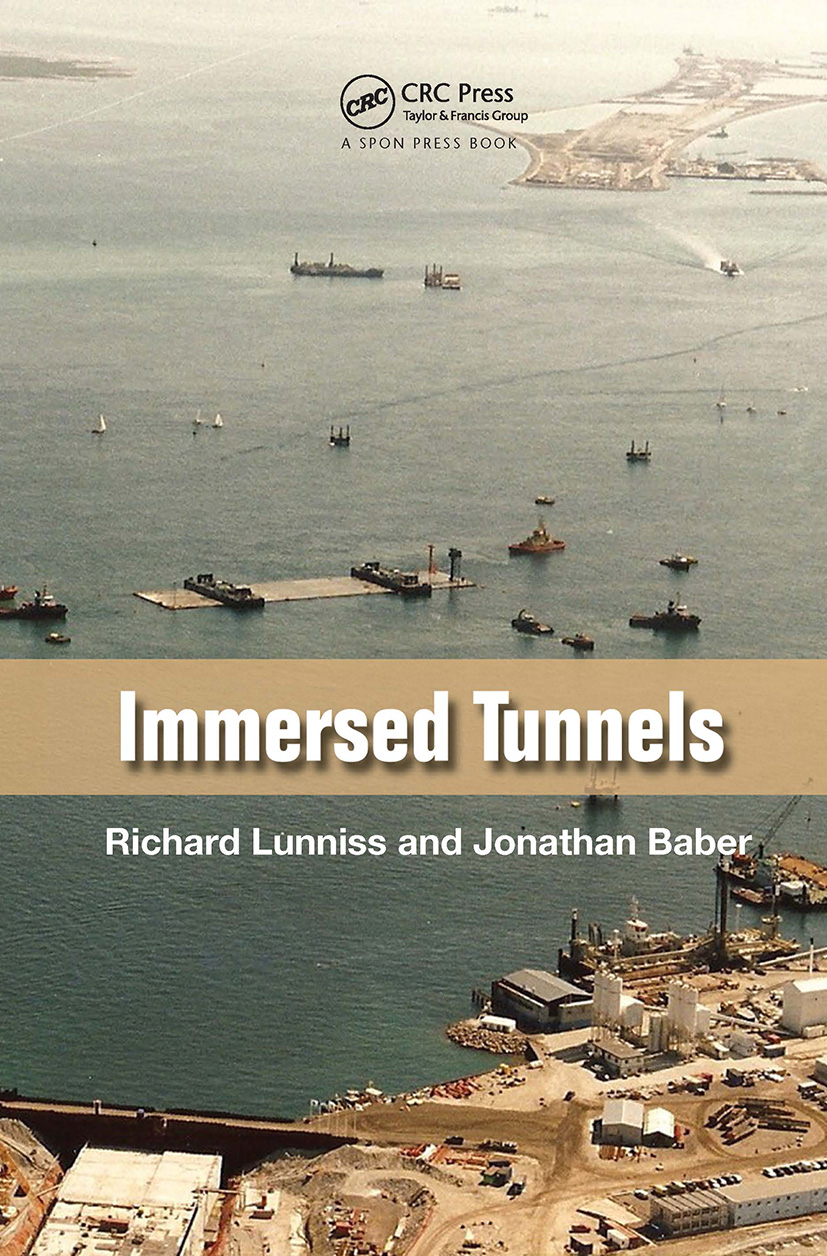IMMERSED TUNNELS
Richard Lunniss, Jonathan Baber
Immersed tunnels have been around for more than a century but remain a relatively unknown form of tunnel construction. For waterway crossings they are an effective alternative to bored tunnels and bridges, particularly in shallower waters, soft alluvial soils, and earthquake-prone areas. Successful implementation requires a thorough understanding of a wide variety of civil engineering disciplines and construction techniques. Immersed Tunnels brings together in one volume all aspects of immersed tunnels from initial feasibility and planning, through design and construction, to operation and maintenance.
Get Valuable Insights into Immersed Tunnel Engineering from Expert Practitioners
The book presents design and construction principles to give a full appreciation not only of what is involved in an immersed tunnel scheme but also how potential problems are dealt with and overcome. It examines important factors that have to be considered, particularly environmental implications and mechanical and electrical systems. It also gives practical examples of how specific techniques have been used in various projects and highlights issues that designers and constructors should be aware of. In addition, the book discusses operation and maintenance and reviews contractual matters. These aspects are described from the viewpoint of two experienced practitioners in the field who have a wealth of experience on immersed tunnel projects worldwide.
As tunnels are increasingly being adopted as engineering solutions around the world, this unique and extensively illustrated reference explores the wide variety of immersed tunnel techniques available to designers and constructors. It provides essential insight for anyone involved, or seeking to be involved, with immersed tunnel projects.
INDEX
Steel shell tunnelsGet Valuable Insights into Immersed Tunnel Engineering from Expert Practitioners
The book presents design and construction principles to give a full appreciation not only of what is involved in an immersed tunnel scheme but also how potential problems are dealt with and overcome. It examines important factors that have to be considered, particularly environmental implications and mechanical and electrical systems. It also gives practical examples of how specific techniques have been used in various projects and highlights issues that designers and constructors should be aware of. In addition, the book discusses operation and maintenance and reviews contractual matters. These aspects are described from the viewpoint of two experienced practitioners in the field who have a wealth of experience on immersed tunnel projects worldwide.
As tunnels are increasingly being adopted as engineering solutions around the world, this unique and extensively illustrated reference explores the wide variety of immersed tunnel techniques available to designers and constructors. It provides essential insight for anyone involved, or seeking to be involved, with immersed tunnel projects.
INDEX
Introduction
Development of the Immersed Tunnel
Development of the Immersed Tunnel
Concrete tunnels
Composite sandwich tunnels
Tunnels in Japan
Growth in immersed tunnels worldwide
Current Forms of Immersed Tunnel
Monolithic concrete element construction
Segmental concrete element construction
Prestressed concrete
Single steel shell
Double steel shell
Composite concrete steel sandwich
Developing an Immersed Tunnel Scheme
Selection of bridge or tunnel
Tunnel cross section
Alignment
Junction with cut and cover tunnels
Number of tunnel elements
Geotechnical
Structural options
Element construction
Environmental considerations
Disruption to navigation
Cost
Operation and maintenance costs
Construction program
Environmental Impact
Short-term versus long-term impacts
Tunnel approaches
Marine works
Fisheries
Algae
Water quality
Visual aspects
Portals
Noise
Air quality
Marine Environment
Hydrography
Hydraulic effects
Modeling
Mechanical and Electrical Installations
Road tunnel safety
Incident detection and management
Emergency escape
Railway tunnel safety
Ventilation
Lighting
Control systems
Power supply
Drainage
Tunnel Approaches and Service Buildings
Forms of approaches
Cut and cover tunnels
Approach ramps
Interface with immersed tunnel
Construction sequence
Connection to bored tunnels
Use of tunnel approaches as the casting basin
Service building facilities
Layout of tunnel portal areas
Design Principles
Structure sizing
Stability and buoyancy
Design loadings
Temporary load conditions
Design codes
Load combinations
Structural analysis
Structural design
Settlement modeling
Seismic design
Joints
Immersion joints
Segment joints
Terminal joints
Closure joints
Crown seal joint
Seismic joints
Durability
Watertightness
Concrete mix design
Early age crack control
Membranes
Corrosion prevention strategies
Cathodic protection
Durability of watertight seals
Internal coatings
Foundations
Foundation layer
Sand foundation layers
Gravel foundation layers
Grouted foundations
Piled foundations
Ground improvement
Earthworks
Dredging
Backfill
Cut-and-cover tunnel earthworks
Casting basin
Artificial islands
Construction and Placing of Tunnel Elements
Concrete tunnels
Steel tunnels
Utility tunnels
Temporary works equipment
Float up
Transportation
Immersion
Ballast exchange
Lessons learned
Finishing Works
Tunnel entry procedures
Joints
Ballast concrete
Fire protection
Cladding, kerbs, and crash barriers
Drainage
Rail tracks and road surfacing
M&E installation
Operation and Maintenance
Operation
Maintenance
Rail tunnels
Contract Forms
Form of contract
Contract documents
Ground conditions
Dispute resolution
Insurance
Payment
Privately financed construction
The Future
Going longer
Going deeper
Materials
Submerged floating tunnels
Location
Glossary
References
Index
Observaciones 2013
Medidas 17x24
Paginas 535
Precio 135,00 Euros.

